Casablanca, a name that resonates with mystery, romance, and adventure, thanks largely to Hollywood’s portrayal, stands today as much more than a cinematic icon. It is Morocco’s largest city, a bustling metropolis that blends modernity with rich cultural heritage, serving as a mirror to the country’s heart and soul. As the economic powerhouse of Morocco, Day trips from Casablanca showcases a unique juxtaposition of contemporary skyscrapers and historic buildings, a testament to its evolution through time.
The city’s heartbeat is found not just in its architectural marvels or its thriving economy but in the vibrant life that pulsates through its streets. The Hassan II Mosque, with its towering minaret, stands as a beacon of Islamic architecture and faith, overlooking the Atlantic Ocean. This architectural masterpiece invites not only the faithful but also curious travelers from around the world, symbolizing the open arms of a city ready to embrace all.
However, Casablanca’s allure as a starting point for exploration lies not only in its physical beauty and architectural wonders but also in its strategic location. Located along the Atlantic coast, it serves as a gateway to the diverse landscapes and cultural experiences that Morocco offers. From the bustling medinas and souks filled with colorful crafts and spices to the serene beauty of the Moroccan countryside, Casablanca offers an unparalleled starting point for journeys that promise to be as diverse as they are enchanting.
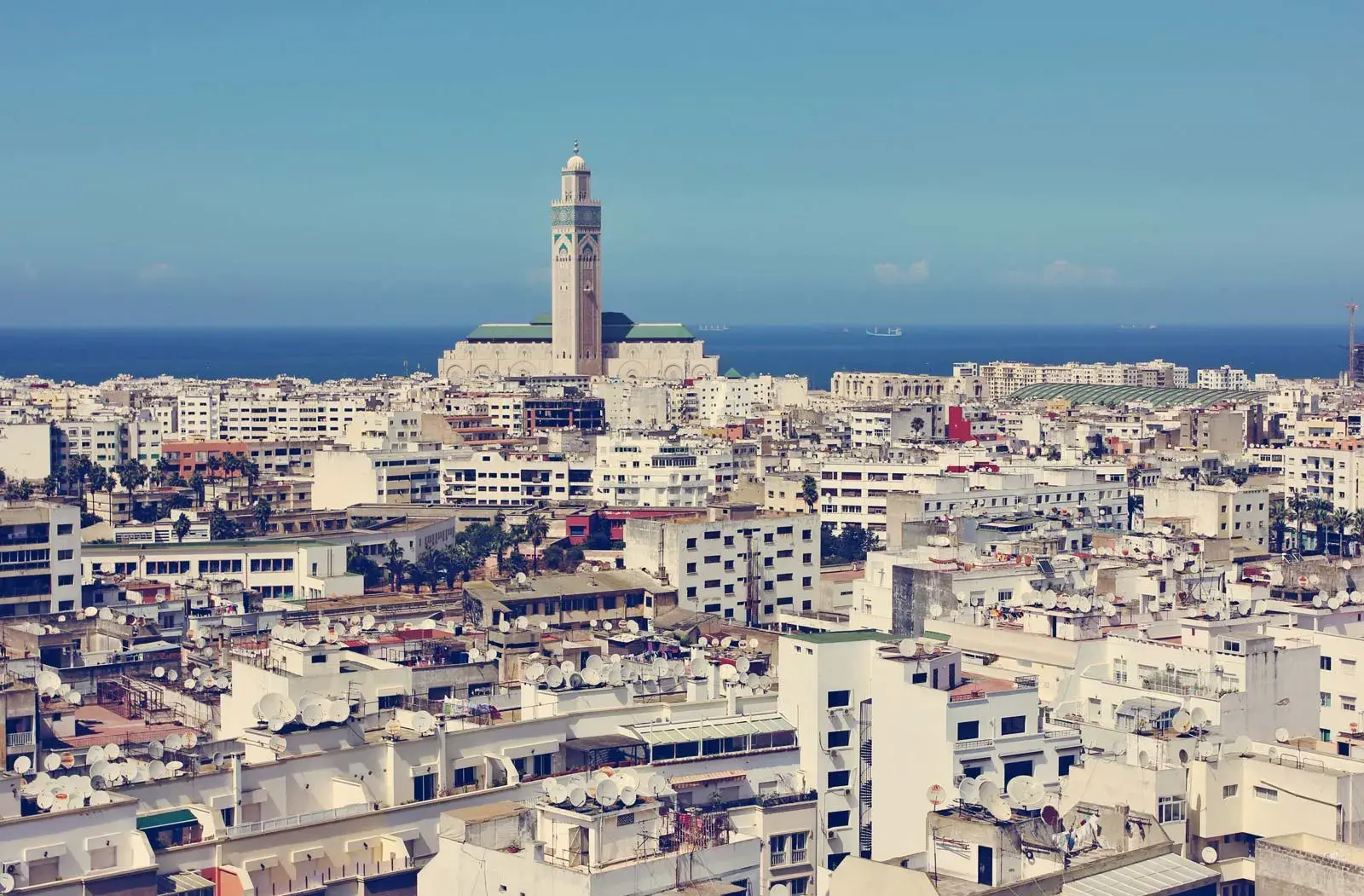
Source: Britannica
Exploring the city itself provides a glimpse into the soul of Morocco, where tradition and modernity coexist harmoniously. A stroll through the Quartier Habous, the new medina, offers a maze of shops selling traditional Moroccan goods, from leatherwork to baked goods, set against the backdrop of French colonial architecture. This blend of cultures is a recurring theme in Casablanca’s narrative, showcasing the city’s role as a melting pot where cultures converge.
Culturally, venturing out from Casablanca allows travelers to immerse themselves in the rich tapestry of Moroccan life. The music, cuisine, and art that one encounters on these journeys are not just expressions of cultural identity but invitations to understand and participate in the Moroccan way of life. Moreover, Casablanca’s role as a starting point for exploration underscores the importance of journeying with openness and curiosity. Day trips from Casablanca is not just a movement through space but a journey through time, offering insights into the history that shaped Morocco, from ancient civilizations through colonial times to the vibrant, independent nation it is today.
The Majestic Marrakech: A Journey to the Red City
Embarking on tay trips from Casablanca to the heart-stirring hues of Marrakech, travelers find themselves drawn into a world that juxtaposes the serene with the vibrant, the ancient with the modern. Known affectionately as the Red City, Marrakech enchants visitors with its earth-toned walls that glow under the sun, a labyrinth of souls brimming with the scent of spices and the echoes of history, and the pulsating life of its squares, particularly the iconic Jemaa el-Fnaa. This narrative seeks to unwrap the layers of Marrakech, guiding through its narrow alleys, unraveling the secrets of its historical landmarks, and immersing in the cultural spectacle that is Jemaa el-Fnaa Square.
Navigating the Vibrant Souls and Historical Landmarks
The exploration of Marrakech begins with its souks, a sprawling network of market streets that form the throbbing heart of the Medina. Here, every sense is awakened. The air carries a palette of aromas, from the earthy scent of leather to the sweet fragrance of fresh mint and the spicy notes of cumin and saffron. The souks of Marrakech are more than mere markets; they are a kaleidoscope of Moroccan life, where artisans craft with age-old techniques, from the weaving of Berber rugs to the delicate art of silver smithing.
Beyond the bustling market streets, Marrakech’s historical landmarks beckon. The Koutoubia Mosque, with its magnificent minaret dominating the skyline, serves as a beacon for those navigating the city. Though non-Muslims may not enter, its presence is a reminder of the city’s spiritual heritage. Close by, the Saadian Tombs offer a serene counterpoint to the bustling streets, with their intricate mosaic tiles and quiet gardens, a testament to the city’s golden age.
The Bahia Palace, another jewel in Marrakech’s architectural crown, unfolds in a series of courtyards and rooms adorned with stucco, cedarwood, and colored glass. This 19th-century palace encapsulates the opulence of Moroccan royalty, offering a glimpse into the lives of those who once walked its halls. Similarly, the Ben Youssef Madrasa, once the largest Islamic college in Morocco, dazzles visitors with its exquisite Islamic architecture, an intricate blend of carved wood, stucco, and zellij tiles.
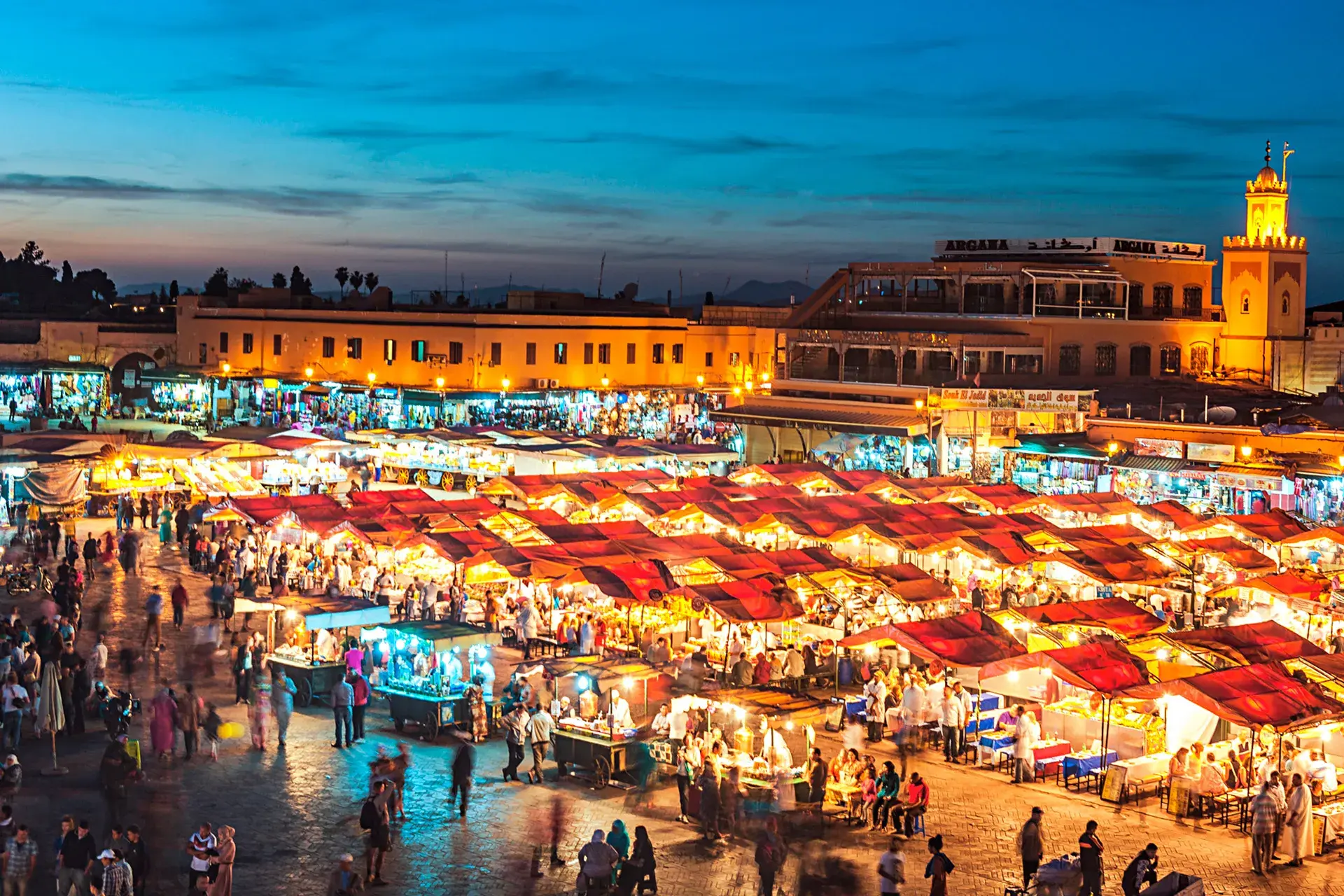
Source: British GQ
The Blue Pearl of Morocco: Chefchaouen
Chefchaouen, located in the heart of the Rif Mountains,often referred to as the Blue Pearl of Morocco, offers a reprieve from the bustling life found in Morocco’s larger cities like Casablanca. Its serene beauty, characterized by blue-washed buildings and narrow lanes, invites travelers into a world where time seems to slow down, allowing for a journey of both tranquility and adventure. This article aims to explore the enchanting allure of Chefchaouen, unveiling the tranquility of its blue streets and the adventure that awaits in the surrounding Rif Mountains.
The journey into the heart of Chefchaouen is one that begins with awe, as one is immediately enveloped by the tranquility of its famed blue streets. The origins of the blue paint, a mixture of tradition, practicality, and spirituality, remain a subject of fascination. Some say it was introduced by Jewish refugees in the 1930s, symbolizing the sky and heaven, encouraging a life of spiritual awareness. Others believe the blue serves to repel mosquitoes or to keep the houses cool during the summer months. Regardless of its origins, the blue hue of Chefchaouen sets it apart, creating a visual symphony that calms the soul.
Wandering through Chefchaouen’s medina, the sense of serenity deepens with every step. The streets, a labyrinth of azure, are lined with artisanal shops offering leather goods, woven baskets, and traditional Moroccan attire, all infused with the town’s signature color. The Plaza Uta el-Hammam is the heart of the medina, where the striking contrast of the red-tiled Kasbah against the blue backdrop captures the essence of Chefchaouen’s unique beauty. The beauty of Chefchaouen is not just in its color but in its simplicity and the warmth of its people. It’s a town that embraces with open arms, where locals share stories of their heritage and traditions, further enriching the visitor’s experience. The sense of community and the shared pride in their city’s unique charm make exploring Chefchaouen a deeply personal journey for many.
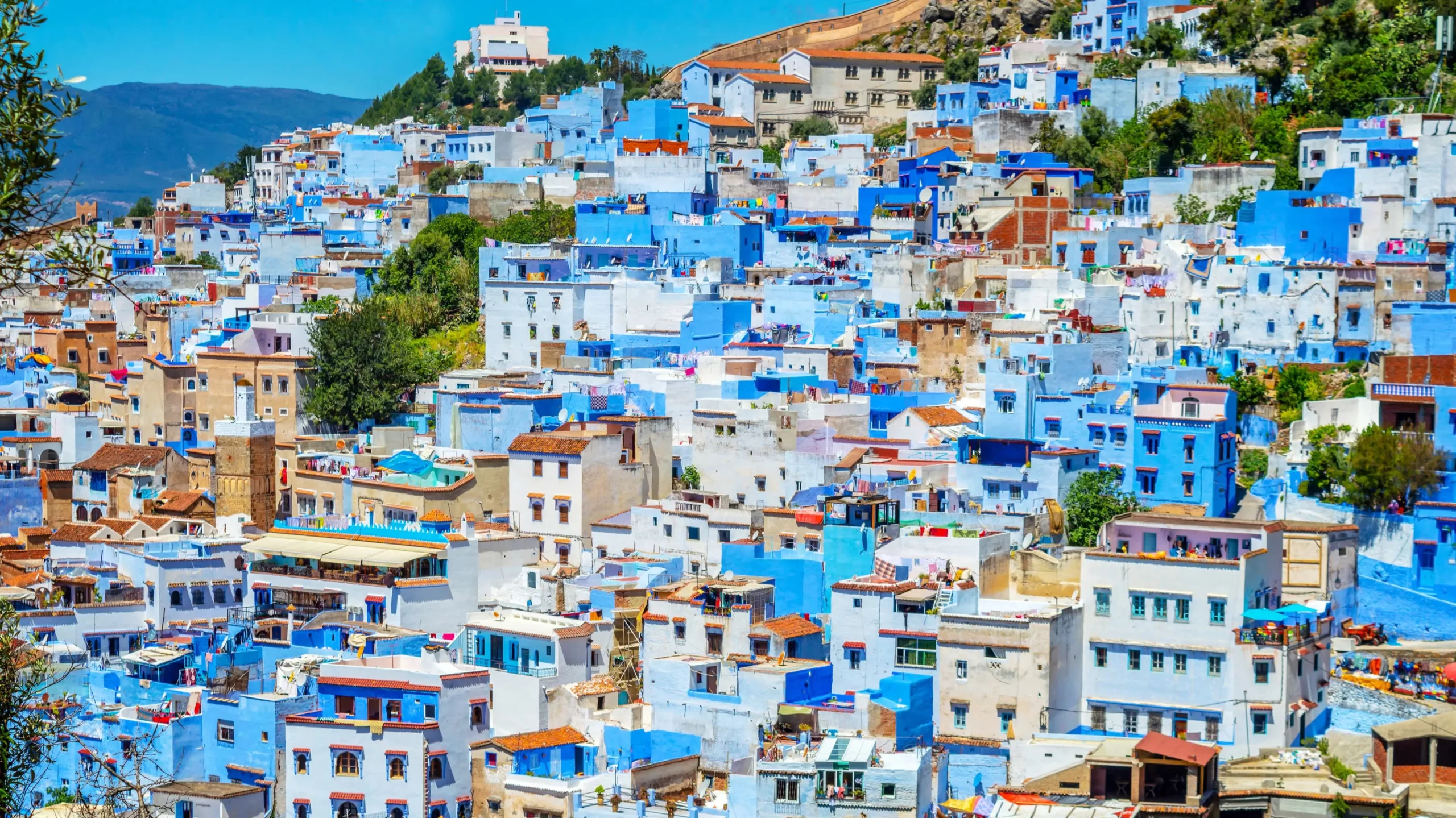
Source: Tourlane
Adventure and Tranquility in the Rif Mountains
While Chefchaouen’s serene streets offer a journey of tranquility, the surrounding Rif Mountains call out to the adventurous spirit. The mountains offer a stark contrast to the peaceful life within the city, presenting rugged landscapes that beckon to be explored. Hiking trails of varying difficulties weave through the mountains, leading to breathtaking vistas and secluded spots that promise solitude and reflection.
Chefchaouen serves as the perfect base for these mountainous adventures, offering a blend of tranquility and thrill that caters to a wide array of preferences. The contrast between the calming blue of the city and the wild, untamed beauty of the Rif Mountains encapsulates the diverse experiences Morocco has to offer.
Imperial Meknes and the Ancient Roman Ruins of Volubilis
Venturing into the heartland of Morocco unveils a journey less trodden, leading to the imperial city of Meknes and the ancient ruins of Volubilis. This narrative delves into the historical tapestry of Morocco, exploring the grandeur of Meknes, one of the country’s four imperial cities, and stepping back in time at Volubilis, a testament to the far-reaching influence of the Roman Empire in North Africa. Together, these sites offer a unique lens through which to view the rich, complex layers of Moroccan history and culture.
Exploring Morocco’s Lesser-Known Imperial City: Meknes
Located between the fertile plains of the Middle Atlas Mountains and the rugged landscapes that lead to the Sahara, Meknes holds a distinct place in Morocco’s imperial past. Unlike its more frequented counterparts—Marrakech, Fez, and Rabat—Meknes exudes a quieter dignity, making it a treasure trove for those seeking to immerse themselves in Morocco’s royal heritage without the crowds.
Venturing inside, the medina of Meknes unfolds with a labyrinth of streets that whisper stories of bygone eras. The Dar Jamai Museum, once a palace, now houses artifacts that showcase the opulent lifestyle of the Moroccan elite, offering insights into the craftsmanship and artistic expression of the time. The nearby Mausoleum of Moulay Ismail, open to non-Muslim visitors, provides a serene glimpse into the spiritual and regal dimensions of Morocco’s past.
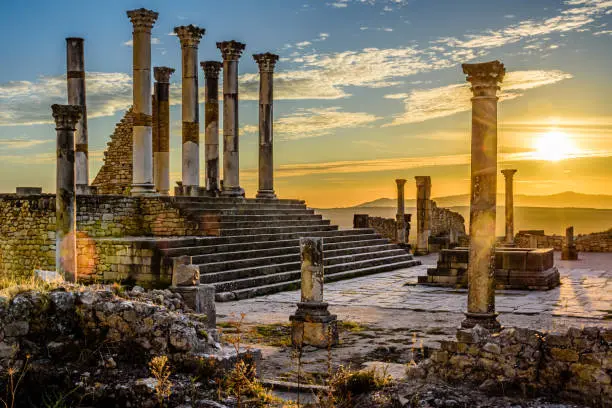
Source: iStock
The Coastal Retreat: A Day in Essaouira
Essaouira, with its windswept beaches and enchanting medina, stands as a testament to the peaceful coexistence of diverse cultural influences that have shaped its identity over centuries. Known for its relaxed atmosphere, distinct from the hustle and bustle of Morocco’s larger cities, Essaouira offers a unique blend of natural beauty and architectural wonder, making it an ideal retreat for those seeking tranquility and a rich cultural experience. This exploration delves into the essence of Essaouira, revealing the charm of its coastal landscapes and the architectural fusion that narrates the town’s history.
Embracing the Windswept Beaches and Charming Medina
The journey into Essaouira’s heart begins at its expansive beaches, where the Atlantic Ocean meets golden sands under the watchful gaze of the town’s historic fortifications. Known as the ‘Wind City of Africa’, Essaouira’s breezy climate makes it a haven for windsurfers and kite surfers from around the globe. Yet, the appeal of its shores extends beyond water sports enthusiasts. The beaches offer a serene escape where one can walk for miles, lulled by the sound of crashing waves, the smell of salt in the air, and the touch of the ocean breeze.
Moving from the tranquility of the beach into the medina, the shift in atmosphere is palpable. Enclosed by ancient walls, Essaouira’s medina, a UNESCO World Heritage site, is a maze of narrow alleyways, bustling souks, and vibrant squares that pulse with the rhythms of daily Moroccan life. Unlike the medinas of larger cities, Essaouira’s is noted for its laid-back ambiance, where the pace of life slows, and the stress of the outside world seems to dissolve in the air.
Walking through the medina, one is immediately struck by the harmonious blend of architectural styles and influences. The charm of Essaouira’s medina lies not just in its historical significance but in the palpable sense of community among its inhabitants. Artisans craft their wares in open workshops, cats lounge in sun-dappled courtyards, and the air carries the scent of freshly baked bread and the ocean. This is a place where every corner holds a story, every facade a memory of times gone by.
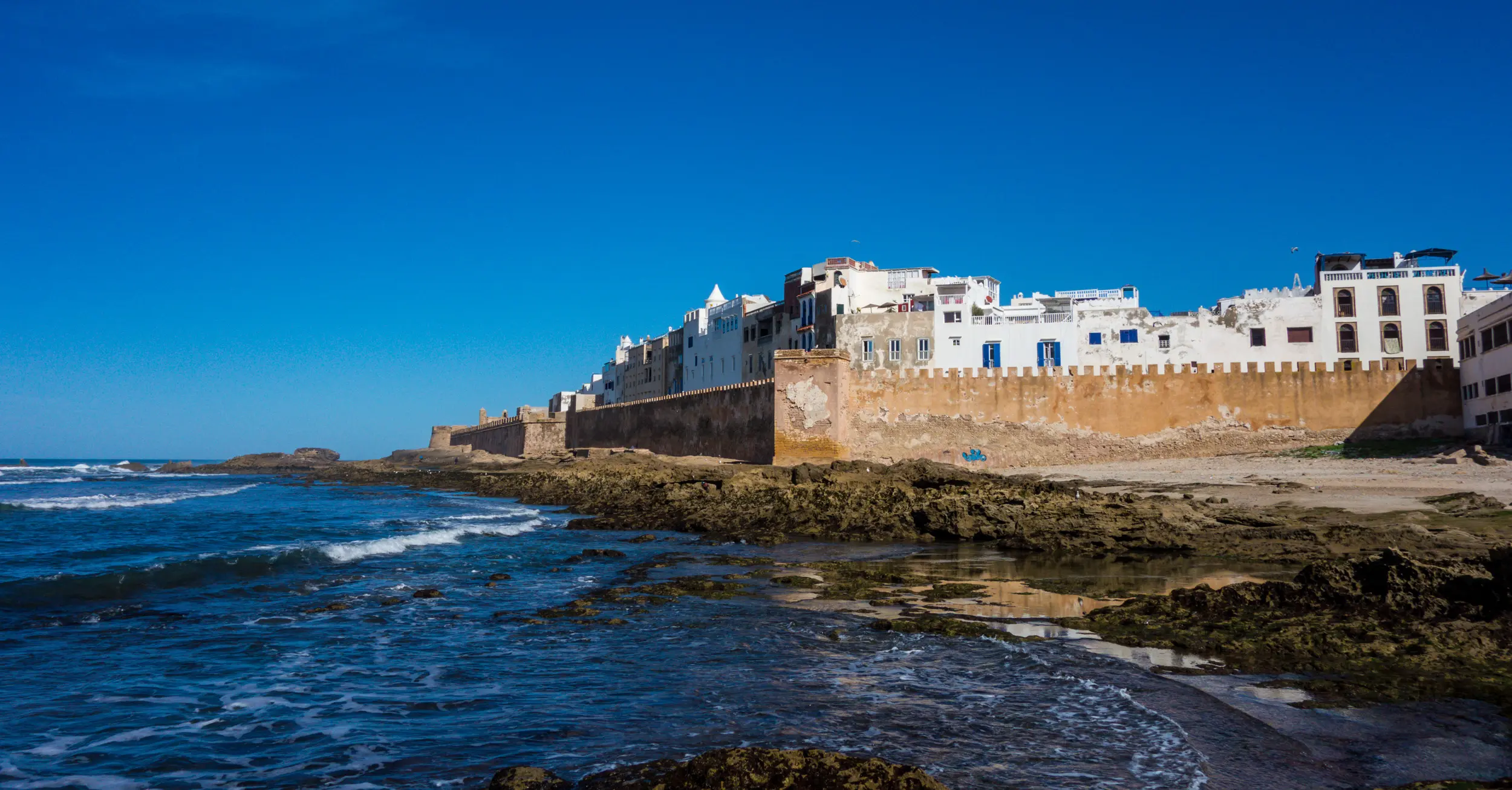
Source: Wikipedia
The Capital City: Rabat’s Rich History and Modernity
Rabat, Morocco’s capital, stands as a city where the threads of history and modernity are intricately woven together, crafting a tapestry that reflects both the nation’s heritage and its contemporary aspirations. As a political and administrative hub, Rabat might not initially spark the same touristic allure as Marrakech or Casablanca. Yet, those who venture into its realms find a city brimming with cultural richness, architectural marvels, and a vibrant arts scene. This exploration delves into Rabat’s dual identity, showcasing the majestic Hassan Tower and the Kasbah of the Udayas as emblems of its historical depth, alongside an examination of the city’s flourishing contemporary culture and art landscape.
The Hassan Tower and the Picturesque Kasbah of the Udayas
Not far from the solemn grandiosity of the Hassan Tower lies the Kasbah of the Udayas, a fortress at the mouth of the Bou Regreg river. Entering through the grand Bab Oudaïa, visitors step into a different era. The kasbah, a maze of narrow blue and white streets, is a tranquil oasis that contrasts with the city’s bustling avenues. It’s a place where the past’s tranquility meets the present’s vibrancy, with its Andalusian gardens offering serene views over the river and the Atlantic Ocean. The Kasbah of the Udayas is not just a historical site but a living neighborhood, embodying the seamless blend of Rabat’s rich history with its modern-day life.
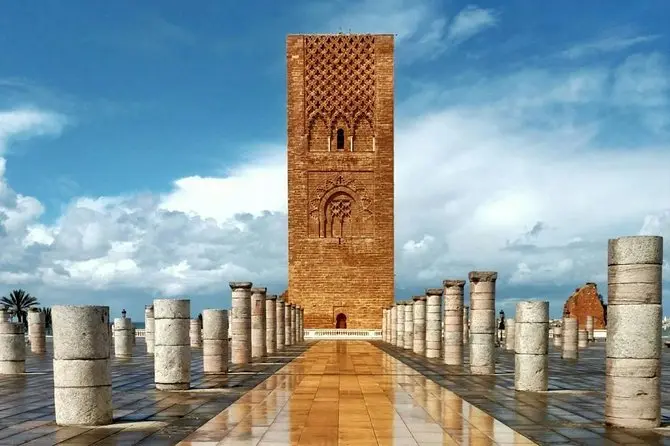
Source: Viator
Rabat’s Contemporary Culture and Art Scene
While Rabat’s historical sites anchor the city in its rich past, its contemporary culture and art scene pulse with the energy of the present. In recent years, Rabat has emerged as a beacon of modern arts and culture in Morocco, with the inauguration of venues such as the Mohammed VI Museum of Modern and Contemporary Art (MMVI). As the first large-scale museum built since the country’s independence, MMVI has put Rabat on the map for art enthusiasts, showcasing a wide range of Moroccan and international art from the 20th and 21st centuries.
Beyond institutional spaces, Rabat’s streets themselves are a canvas for contemporary expression. The city has embraced street art, with murals and installations bringing color and conversation to its urban fabric. The annual Jidar Street Art Festival is a testament to this, transforming the city’s walls into a vibrant gallery of large-scale artworks created by artists from around the globe.
In Rabat, the past and the present do not exist in isolation; they are in constant dialogue. The city’s historical monuments remind visitors and residents alike of the deep roots that ground the nation’s identity. At the same time, its vibrant arts scene and embrace of modernity signal Morocco’s forward-looking aspirations. Rabat, therefore, embodies the synthesis of Morocco’s respect for tradition and its ambition for progress, offering a multifaceted urban experience that captures the essence of Moroccan dynamism.
The Hidden Gem: Azemmour’s Artistic Inspiration
Azemmour, often overlooked in favor of Morocco’s more renowned destinations, is a hidden gem found on the banks of the Oum Er-Rbia River, offering a tranquil retreat rich in art, history, and natural beauty. This small, picturesque city, with its storied past and vibrant cultural scene, invites visitors to explore its unique charm, far removed from the hustle and bustle of larger tourist centers. Azemmour’s blend of history, art, and the serene environment of the Oum Er-Rbia River makes it a sanctuary for those seeking inspiration and a deeper connection with Morocco’s diverse heritage.
The City’s Annual Mural Painting Festival
Perhaps the most captivating aspect of Azemmour’s cultural landscape is its annual mural painting festival, which transforms the city into a vibrant canvas for artists from Morocco and beyond. The festival, known as “Remp’Arts Azemmour,” invites artists to leave their mark on the city’s walls, resulting in a stunning array of murals that adorn the medina and surrounding areas. These artworks range from traditional Moroccan motifs to contemporary designs, reflecting a wide spectrum of artistic expression and creating a dynamic open-air gallery that evolves with each edition of the festival.
This celebration of art not only beautifies the city but also fosters a sense of community and creativity among its residents and visitors. The festival has become a source of pride for Azemmour, attracting art enthusiasts and tourists eager to witness the transformation of the city’s public spaces into a testament to the power of creativity and collaboration. It provides a platform for dialogue between cultures, as artists bring their unique perspectives and styles to the city’s historic walls, enriching Azemmour’s cultural tapestry.
Azemmour, with its blend of history, art, and natural beauty, offers a unique experience for those willing to venture off the beaten path. The city’s annual mural painting festival is a highlight, showcasing the vibrant spirit of the community and the transformative power of art.
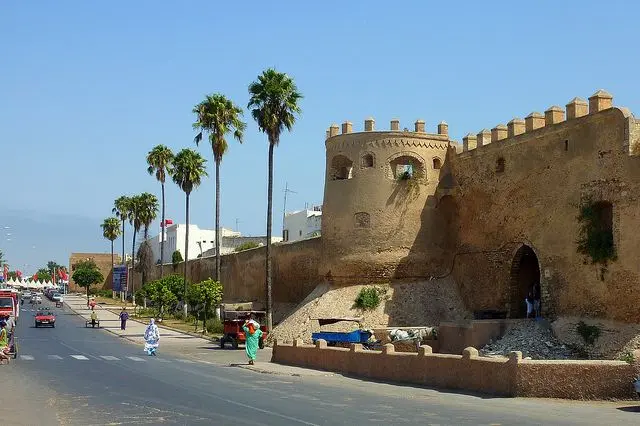
Source: Pinterest
The Thrill Seeker’s Delight: Oukaimeden’s Winter Sports
Oukaimeden, perched high in the Atlas Mountains, transforms into a winter wonderland, offering a unique skiing experience that stands in stark contrast to the arid landscapes commonly associated with Morocco. This unexpected thrill-seeker’s paradise provides an exhilarating escape for those looking to combine the adventure of winter sports with the allure of the mountains. Beyond the winter months, Oukaimeden seamlessly transitions into a haven for hikers and mountain bikers, making it a year-round destination for outdoor enthusiasts.
From Casablanca to the Slopes: Skiing in the Atlas Mountains
The journey from the bustling city of Casablanca to the tranquil slopes of Oukaimeden is a testament to Morocco’s diverse geography. Travelers leave behind the coastal urban landscape and ascend into the heart of the Atlas Mountains, where Oukaimeden awaits, located at an altitude that ensures a consistent blanket of snow during the winter months. This ski resort, the highest in Africa, offers a range of slopes suitable for both beginners and experienced skiers, providing a unique opportunity to glide down the mountains with panoramic views of the surrounding peaks and valleys.
Equipped with chairlifts and ski rentals, Oukaimeden makes this exhilarating experience accessible to all. The resort’s location, coupled with Morocco’s sunny climate, ensures that skiing conditions are ideal, with blue skies and crisp mountain air enhancing the experience. Skiers and snowboarders can enjoy the thrill of the descent, while those new to winter sports have access to instructors ready to introduce them to the joys of skiing and snowboarding.
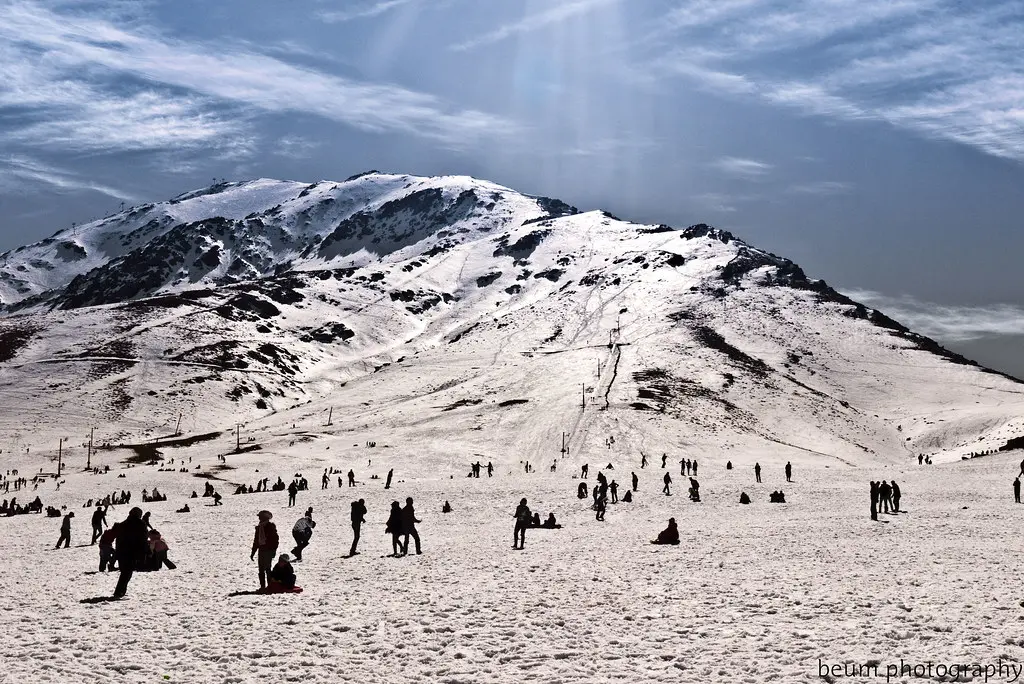
Source: Flickr
The Wine Route: Meknes and Its Vineyards
The Meknes region, located between the Rif and the Middle Atlas mountains, is the heartland of Morocco’s burgeoning wine industry, offering a unique experience far removed from the traditional images of bustling medinas and sweeping deserts. This fertile area, blessed with a favorable climate and rich soils, is home to some of the country’s most esteemed vineyards, making it an essential destination for oenophiles and curious travelers alike. The Wine Route of Meknes invites visitors to indulge in Morocco’s lesser-known wine culture, providing an opportunity to explore the sophisticated world of winemaking and taste the fruits of this ancient land.
Indulging in Morocco’s Lesser-Known Wine Culture
Morocco’s winemaking history is as rich and complex as its wines, with roots stretching back to the Phoenician and Roman times. However, it was the French influence during the protectorate in the 20th century that truly transformed the Meknes region into the winemaking powerhouse it is today. Despite being a Muslim-majority country, Morocco has carved out a niche for itself in the global wine market, with Meknes leading the charge.

Source: Research gate
Vineyard Tours and Tastings in the Region’s Estates
Embarking on a vineyard tour in the Meknes region is not only a journey through the scenic landscapes of rolling hills and lush valleys but also an educational experience that offers insights into the winemaking process. Many estates welcome visitors with open arms, providing guided tours that cover the journey of the grape from vine to bottle. These tours often culminate in tastings, where guests can sample a selection of the estate’s finest wines, learning to appreciate the subtleties of aroma, flavor, and texture that distinguish Moroccan wines.
One of the highlights of exploring the Wine Route is the opportunity to visit some of the region’s most renowned estates, such as Chateau Roslane, Domaine de la Zouina, and Les Celliers de Meknes. These estates not only produce some of the best wines in Morocco but are also known for their stunning architecture and beautiful gardens, making them a feast for the senses.
The Berber Heartland: A Visit to the Atlas Mountains
The mountains serve as the backbone of Morocco, stretching across the country and housing diverse ecosystems and communities that have maintained their traditions for centuries. Here, the rugged peaks and serene valleys tell the story of the Berber people, offering travelers a unique blend of cultural encounters and outdoor adventures. This exploration delves into the essence of the Atlas Mountains, highlighting the cultural richness and the myriad of trekking opportunities that await within its majestic terrains.
Cultural Encounters and Breathtaking Natural Landscapes
The Atlas Mountains are home to the indigenous Berber people, known for their rich history, language, and customs that predate Arab influence in North Africa. A visit to the Berber heartland is a testament to the resilience and hospitality of these communities, who welcome travelers into their homes and lives with open arms. The landscape is dotted with traditional mud-brick villages that cling to mountain sides, terraced agricultural fields, and bustling weekly markets where locals trade goods and socialize, offering a glimpse into the everyday life of the Berber people.
The natural beauty of the Atlas Mountains is unparalleled, with each region offering its own unique allure. From the snow-capped peaks of Toubkal, North Africa’s highest point, to the lush valleys of the Ourika and Amizmiz regions, the Atlas Mountains boast diverse ecosystems that support a wide range of flora and fauna.

Source: Voyage Prime
Agadir and the Atlas Mountains’ Gateway
Agadir, with its sun-soaked beaches and status as the gateway to the Atlas Mountains, offers a unique blend of seaside relaxation and rugged mountain adventures. This coastal city, rebuilt with a modern twist after the devastating earthquake of 1960, stands as a testament to Moroccan resilience and forward-thinking. Its geographical positioning makes it an ideal starting point for explorers looking to indulge in the beauty of Morocco’s coastline while being within reach of the Atlas Mountains’ majestic landscapes. This exploration dives into Agadir’s offerings, from its renowned beaches to the adventure and nature awaiting just a stone’s throw away in the Atlas.
Sun, Sea, and Sand: Exploring Agadir’s Beaches
Agadir’s main draw is undoubtedly its expansive crescent beach, stretching for about 10 kilometers along the Atlantic. The soft golden sands, complemented by the city’s 300 days of sunshine a year, make it a paradise for sun-seekers and water sports enthusiasts alike. The promenade, lined with cafes, restaurants, and shops, pulsates with life, offering a vibrant backdrop to the serene beach experience. Here, one can indulge in activities ranging from camel rides along the shore to jet skiing and windsurfing, taking advantage of the favorable wind conditions that Agadir is blessed with.
The beach is not just a daytime destination; evenings bring a different vibe, with locals and tourists alike strolling along the promenade, enjoying the cooler air and the sunset views. Agadir’s beaches serve as a social hub, a place where the relaxed Moroccan lifestyle is on full display, inviting visitors to slow down and savor the moment.

Source: Britannica
The Atlas Mountains’ Doorstep: Nature and Adventure
Just beyond the city’s modern façade lies the gateway to the Atlas Mountains, a world away from the coastal calm of Agadir. This proximity to the mountains offers visitors an easy transition from the lazy beach days to the exhilarating adventures that await in the Atlas. From Agadir, the journey into the Atlas Mountains is not just a physical one; it’s a journey through time, where the ancient landscapes and the enduring spirit of the Berber people provide a stark contrast to the city’s modernity. This unique combination of beach leisure and mountain adventure makes Agadir an unparalleled destination for those looking to experience the best of both worlds. The city’s ability to offer sun, sea, sand, and immediate access to the natural and cultural wonders of the Atlas Mountains cements its place as a must-visit location in Morocco, appealing to a wide range of tastes and interests.
Spiritual Journey: The Ancient City of Fez
Fez, one of the oldest imperial cities in Morocco, is a spiritual and cultural heartland that has captivated travelers, scholars, and mystics for centuries. This city, founded in the 8th century, is an enduring symbol of the country’s rich history, spiritual depth, and artisanal excellence. The ancient medina of Fez, a UNESCO World Heritage site, is a labyrinth of narrow streets and alleys that house mosques, madrasas, and palaces, standing as a testament to the city’s medieval past and its importance as a spiritual and intellectual center. This exploration delves into the essence of Fez, highlighting its timeless medina, spiritual heritage, and the unique crafts that have flourished within its walls.
The Timeless Medina and Spiritual Heritage
Fez’s medina, known as Fes el-Bali, is not just the heart of the city but the soul of Morocco. Entering the medina is like stepping back in time; the sounds of modernity fade away, replaced by the echo of craftsmen at work and the call to prayer from the myriad mosques that dot the landscape. The Kairaouine Mosque and University, founded in 859, is among the oldest and most revered educational and religious institutions in the Muslim world, symbolizing Fez’s role as a spiritual beacon. This institution has been a center for Islamic scholarship and theology for centuries, attracting students and scholars from across the Islamic world.
The medina’s narrow streets are lined with historic madrasas, such as the Al-Attarine and Bou Inania, which are marvels of Islamic architecture, featuring intricate tile work, carved cedar wood, and stucco plaster. These buildings not only serve as places of learning but also as places of reflection and prayer, contributing to the medina’s profound sense of spirituality.
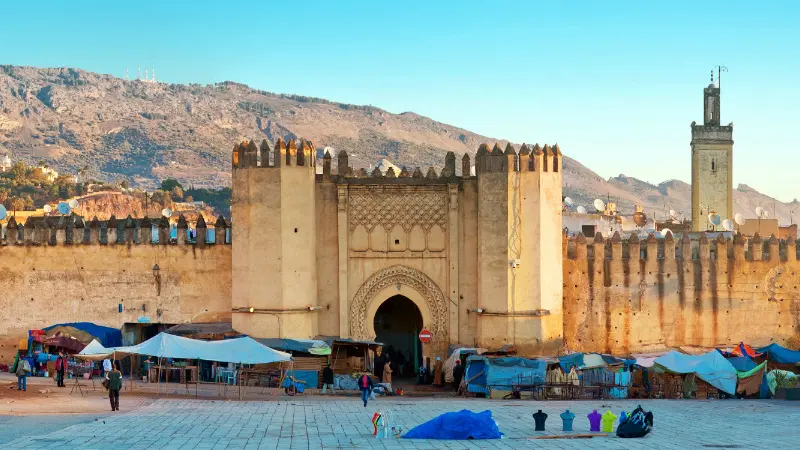
Source: AFKTravel
The Unique Leather Tanneries and Artisanal Crafts
Fez is renowned for its artisanal crafts, a tradition that has been preserved and passed down through generations. The city’s leather tanneries, in particular, are a spectacle of color and activity that has remained largely unchanged since medieval times. The Chouara Tannery, the largest and most famous, offers a glimpse into the labor-intensive process of turning animal hides into beautifully dyed leather, using methods that have been employed for centuries. Visitors to the tanneries can observe the artisans working in the dye pits and browse the finished products in the surrounding shops, providing a direct link between the craft and the consumer.
Beyond leather, Fez is a treasure trove of artisanal crafts, including ceramics, metalwork, and textiles. The city’s craftsmen are masters of their trade, whether it’s creating intricate zellij tilework, forging elaborate brass lanterns, or weaving delicate fabrics. These crafts are not merely souvenirs but pieces of Fez’s cultural and spiritual identity, imbued with the history and skill of the artisans who create them.
The Lure of the Desert: Day Trip to the Sahara
The allure of the Sahara Desert, with its vast, undulating sands and mesmerizing landscapes, has long captivated the imagination of travelers on day trips from Casablanca. This majestic wilderness represents not just the physical extremity of the natural world but also a journey into a realm of timeless beauty and profound tranquility. Embarking on a day trip to the Sahara from the bustling cities of Morocco offers a stark contrast to urban life, providing an immersive experience into the heart of the desert. This exploration delves into the gateway to the Sahara, highlighting the unique experiences of camel treks and overnight camping under the stars, which together offer a glimpse into the desert’s enchanting allure.
The Gateway to the Sahara: Experiencing Morocco’s Desert Beauty
The journey to the Sahara often begins at the edge of the desert, where the landscape gradually shifts from fertile valleys to rocky plateaus and finally to the iconic sand dunes that have defined the Sahara’s imagery. Places like Merzouga and M’Hamid serve as gateways to the desert, offering travelers their first encounter with the Sahara’s vastness. The sight of the Erg Chebbi or Erg Chigaga dunes, with their towering heights and shifting contours, is an awe-inspiring introduction to the desert’s dynamic beauty.
Venturing into the Sahara, the sense of scale becomes palpable, with the horizon stretching endlessly and the dunes casting ever-changing shadows under the sun. This landscape, seemingly desolate, is alive with the whispers of the wind and the tracks of desert creatures, reminding visitors of nature’s resilience and the desert’s hidden vitality.
One of the most authentic ways to experience the Sahara is on a camel trek, a mode of travel that has traversed these sands for centuries. Riding atop a camel, travelers are afforded a slow, rhythmic passage through the desert, allowing for a profound connection with the surroundings. The pace of the trek invites contemplation, with each step revealing new perspectives of the Sahara’s intricate beauty.

Source: Smithsonian Museum
As the day gives way to evening, the desert transforms under the spectacle of sunset, with colors shifting from golden to deep reds and purples. This magical moment segues into one of the Sahara’s most unforgettable experiences: overnight camping under the stars. Far from the light pollution of cities, the night sky in the Sahara is a dazzling display of constellations and the Milky Way, enveloping campers in a celestial dome of unparalleled clarity.
The overnight camps, ranging from basic bivouacs to luxury tents, offer a comfortable base from which to soak in the desert’s nocturnal wonders. The experience is often complemented by traditional Berber hospitality, with campfires, music, and storytelling, providing insights into the cultural heritage of the desert’s nomadic inhabitants. Sleeping under the stars, surrounded by the silence and vastness of the Sahara, is an experience that resonates with the soul, offering a sense of peace and connection to the cosmos.
The lure of the Sahara lies in its ability to strip away the superfluous, presenting a landscape that is both stark and spectacularly beautiful. A day trip to the desert, culminating in a camel trek and overnight camping, offers not just an escape from the mundane but a journey into the heart of the natural world. It’s an experience that highlights the beauty of simplicity, the majesty of nature, and the enduring allure of the Sahara Desert.
Day Trips From Casablanca: Final Thoughts
The exploration of destinations and experiences near Casablanca unveils a tapestry of cultural, historical, and natural wonders that Morocco offers. From the snow-capped peaks of the Atlas Mountains to the serene beaches of Agadir, the labyrinthine medinas of Fez and Marrakech, and the vast expanse of the Sahara Desert, the region surrounding Casablanca is a testament to the diversity and richness of the Moroccan landscape and its people. This conclusion reflects on the myriad experiences that beckon just beyond the city limits of Casablanca, emphasizing the importance of venturing into the heart of Morocco to fully grasp the essence of this vibrant country.
Casablanca, with its urban charm and architectural marvels, serves as a gateway to a realm of contrasting landscapes and cultural depth. The proximity of Casablanca to both sea and mountain, desert and fertile valley, offers a unique opportunity for day trips from Casablanca within a relatively short distance. The cultural encounters one experiences when stepping beyond Casablanca’s boundaries are profound. They weave together the threads of Morocco’s rich history, from the Berber villages in the Atlas Mountains to the historic imperial cities, each telling a story of resilience, tradition, and progress. These journeys are not merely physical but are also voyages through time, where the past and present coexist, offering lessons in history, architecture, and the enduring spirit of the Moroccan people.
Exploring beyond the city limits of Casablanca is essential for anyone seeking to comprehend the complexity and diversity of Morocco. It is in the varied landscapes and the lives of its people that the true heart of Morocco beats. Venturing into the mountains, deserts, and ancient cities encourages a deeper connection with the natural world and a greater appreciation for the cultural and historical tapestries that define Morocco.
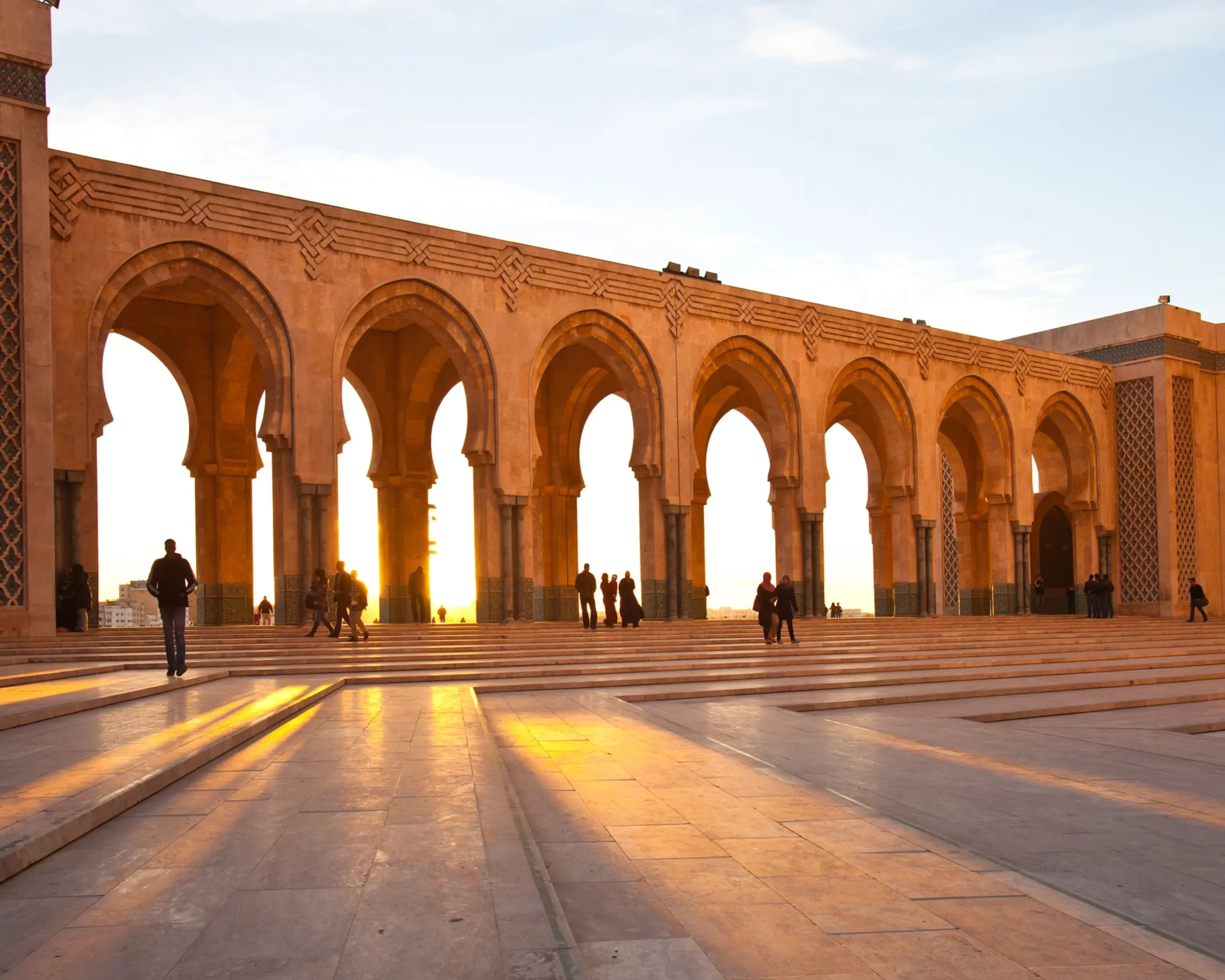
Source: National Geographic
Moreover, these explorations challenge perceptions, broaden horizons, and foster a sense of global citizenship. They remind us of the beauty of diversity, the importance of preservation, and the value of cultural exchange. In stepping out of the urban comfort zone and into the varied terrains that surround Casablanca, travelers not only discover the treasures of Morocco but also gain insights into themselves and the interconnected world we share.
In conclusion, the area surrounding Casablanca is a microcosm of Morocco’s broader allure, offering a mosaic of experiences that captivate the heart, stimulate the mind, and nourish the soul. The richness and diversity of these experiences underscore the importance of exploring beyond the city limits, inviting travelers to embark on day trips from Casablanca that are as enriching as they are enlightening. Through these explorations, Morocco reveals its many layers, each beckoning with the promise of discovery and the enduring charm of a land steeped in history, culture, and natural beauty.



